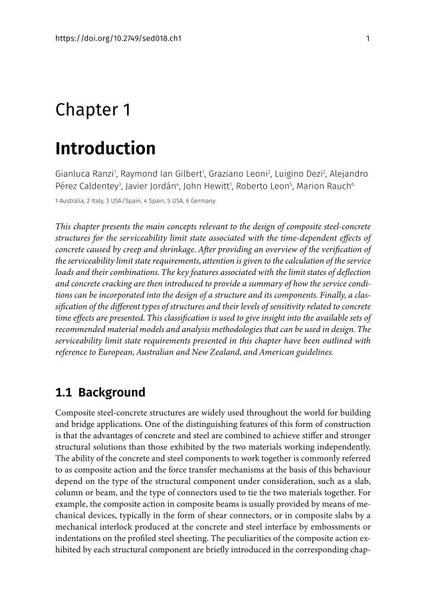Introduction

|
|
|||||||||||
Bibliographic Details
| Author(s): |
Gianluca Ranzi
Raymond Ian Gilbert Graziano Leoni Luigino Dezi Alejandro Pérez Caldentey Javier Jordán (Technical Director, Pedelta) John Hewitt (Adjunct Associate Professor, University of Sydney, Australia) Roberto Leon Marion Rauch (Professor of Steel and Timber Structures, University of Applied Sciences Hochschule Kaiserslautern, Germany) |
||||
|---|---|---|---|---|---|
| Medium: | book chapter | ||||
| Language(s): | English | ||||
| Publisher: | International Association for Bridge and Structural Engineering | ||||
| Published in: | Zurich, Switzerland | ||||
| Published in: | Time-dependent behaviour and design of composite steel-concrete structures | ||||
|
|||||
| Page(s): | 1-12 | ||||
| Total no. of pages: | 13 | ||||
| Year: | 2021 | ||||
| DOI: | 10.2749/sed018.ch1 | ||||
| Abstract: |
This chapter provides an introduction to the constitutive models commonly specified in design guidelines to describe the time-dependent behaviour of concrete and that can be used for the time-dependent analysis of composite structures. These formulations range from the simplest algebraic methods, such as the Effective Modulus Method that is widely recommended in design guidelines, to more sophisticated approaches that can account for creep and shrinkage effects in advanced modelling. The last part of the chapter provides a brief overview of multi-physics modelling that could be useful in predicting the concrete time-dependent response for composite construction. |
||||
| Keywords: |
concrete time-dependent behavior Steel-concrete composite structure
|
||||
| Copyright: | © 2021 International Association for Bridge and Structural Engineering | ||||
